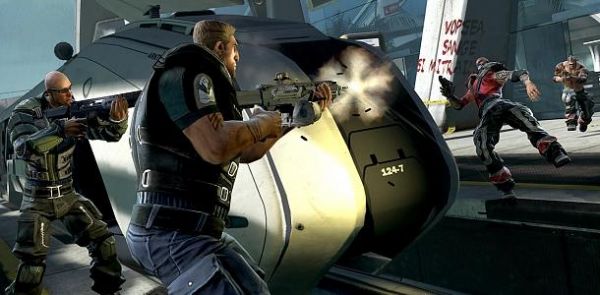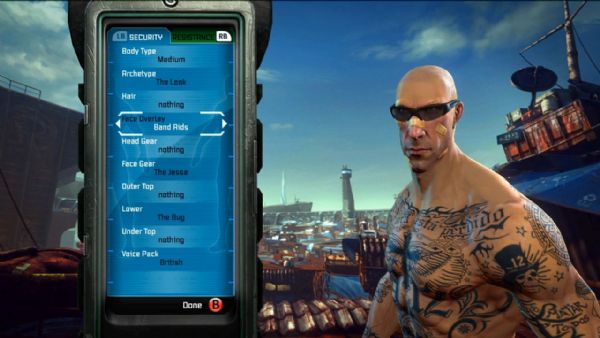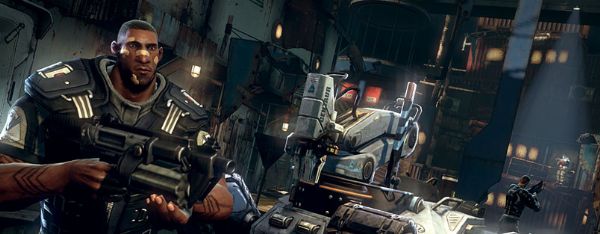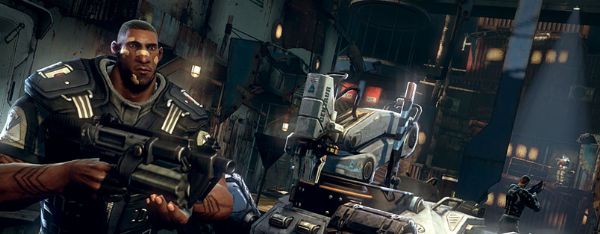On the Brink! Taking it to the Brink! Brinky Brink Panther! Oh, never mind….
Brink is an interesting little oddity: despite churning away in the background for a couple of years now, it never really registered on many gamers’ radars. Developed by Splash Damage (creators of the horribly underrated Quake Wars: Enemy Territory), Brink offers a fast paced, team based on- and offline shooter, based in a dystopian future. Perhaps that’s their first issue there: it doesn’t sound like the newest of concepts, and suffers from a possible lack of identity in today’s swamped team-FPS online offerings. I mean, c’mon, it’s even up against the mighty Battlefield series….
Thankfully, Brink does several things in fresh and new ways. The first thing I noticed were the awesome visuals, ripped straight out of the Timesplitters world (note: Timesplitters NEEDS resurrection … NOW) and then tweaked to keep the quirky style while taking away some of the straight-up comic book colouring. What you end up with is pretty excellent – the characters have believability despite their exaggerated features, and adding in some excellent voice work (mainly because of all the lovely accents employed!) further cements some personality which FPS team mates can often lack. Also, the customisation options are pretty immense, with faces, armour type, styles, tattoos, weapons, customisations and more adding up to “100 quadrillion” (Bethesda’s numbers, not mine) combinations. It quickly becomes clear that this might not be an exaggeration when on the battlefield, as you’d struggle to find any clones during play. Add in the now ubiquitous levelling system, with all its perks and unlocks, and you really can build your own character who plays in the way you do.
So, the basic idea of Brink is simple – you start on a rundown island colony, playing as security (in Blue) or rebels (Red), fighting to gain and keep control via a number of objectives. These objectives fall into familiar territory – attack and defend, zone capture, flag capture, defend the VIP, and more. Several of these are combined into one larger mission within the game field of one match, and obviously a balance is quickly struck – one mission for example, starts with one team escorting a VIP to a safe zone while the other team try to stop them. The outcome of this leads to the next mission – if the defenders are successful, then the next mission for them is to fight their way to activate a computer, while the other team defends. If they failed, they might have the harder task of holding a zone in a tough-to-defend area while the other team can attack from key vantage points.
It’s a system we have seen before, but considering the Enemy Territory series really nailed down the approach, it’s no surprise that Brink really plays out fantastically well during the matches themselves. Teamwork is not just important here, it’s absolutely tantamount to any kind of success, and getting the correct balance of classes available can make all the difference. Despite classes feeling limited (medic, soldier, operative, engineer) when compared to, say, the mighty TF2 (still the benchmark for team based shooters), Splash Damage have done a great job of keeping the talents, skills and weapons specific enough to make every class have a valuable contribution. And often, key objectives need one specific class in order to activate them, leading to frantic class-swapping during mission transitions, and the layout of the team itself changing radically on the fly.
 Then comes the secondary tasks – all available missions are available via a nifty wheel, and often offer two or three choices of how to go about achieving success. So, support roles may be something as simple as destroy a wall or block a passage – but seeing as this can speed up access to the main flashpoints for your teammates, or decrease entry zones to your defence post, you need to decide if it’s worth dedicating the manpower to achieving these goals. And this is where Brink really, really shines – you can’t just run-and-gun, piling all your forces into the main objective. Thinking through your tactics, how to divert resources to key objectives and balancing the player squads can really make a huge, huge amount of difference when on the field.
Then comes the secondary tasks – all available missions are available via a nifty wheel, and often offer two or three choices of how to go about achieving success. So, support roles may be something as simple as destroy a wall or block a passage – but seeing as this can speed up access to the main flashpoints for your teammates, or decrease entry zones to your defence post, you need to decide if it’s worth dedicating the manpower to achieving these goals. And this is where Brink really, really shines – you can’t just run-and-gun, piling all your forces into the main objective. Thinking through your tactics, how to divert resources to key objectives and balancing the player squads can really make a huge, huge amount of difference when on the field.
But here we also come to the key failing of Brink – all modes and missions can be played online or offline, with drop-in, drop-out play, and offline, Brink is a bit of a failure. It works, and works well, but the problem is the computer AI – it isn’t bad, but lacks the communication and co-ordination required to really play Brink at its best. Single player becomes flat and lifeless very quickly, and the paper thin story does little to add any dimension to the gameplay. The much vaunted SMART system is essentially a clever jump/slide key, and doesn’t really add a lot to gameplay – yes, it’s nice to have a one-button-fits-all solution, but the real meat of the game is in the squad balance, the assignment of objectives, and the ever changing front line and objectives. You and your squad is what matters, and how you fit together and work on the task in hand is what will really draw you in.
And even then, you need to have a squad of human players, all with their microphones on, and working together and relaying information for the battle bug to really bite. In a nice touch, wearing a headset even in offline single player brings character chatter, informing you of what is going on, but too often you can’t actually coordinate your teammates into something resembling a coherent human force. An opportunity to integrate the brilliant voice tools used in RTS titles such as Supreme Commander has been missed here, and as a result, Brink falls flat unless you manage to score yourself some likeminded players while online.
And if you do, befriend them, because then Brink lets you in on a secret PC gamers have known for years – the immersion and intensity of a smart, tight, ever changing FPS team battle is second to none. It really becomes one of those titles where you can lose several hours without realising, and actually feel a bit exhausted after playing – no social networking while you play, your team mates need your full attention in case the slightest slip up can make the difference between victory or loss. It’s a nearly unmatched experience.
 I appreciate that Brink has some niche appeal – there’s no point in bothering if you just want to wade in firing, and plenty of games offer that instead. Brink is also going to appear to be merely a full price modkit to many players too, with its limited number of maps (there really needs to be a couple of freebies in the near future) and poor single player. But dig a little deeper, as there is far more going on here, and Brink really shines
I appreciate that Brink has some niche appeal – there’s no point in bothering if you just want to wade in firing, and plenty of games offer that instead. Brink is also going to appear to be merely a full price modkit to many players too, with its limited number of maps (there really needs to be a couple of freebies in the near future) and poor single player. But dig a little deeper, as there is far more going on here, and Brink really shines
once you get a few games in and start to really level up and customise your character, and get online with some other miked-up enthusiasts. The ever-changing objectives, the side missions and the overall polish really add up to quite a special experience, but you really only get out as much as you put in. Get some mates together, spend the time working out your strengths and weaknesses, and lay in a couple of solid hours, and I pretty much guarantee you’ll be hooked. Splash Damage have taken the original template they built, refined it and built on it to really create a great niche gameplay experience, and certainly one that feels quite fresh in a pretty stale genre. Quite simply, Brink is brilliant.
The Bad: Offline is a bit poor; needs player coordination, and fails heavily without it; small number of maps; single player storyline is throwaway
 Silver Y Award
Silver Y Award
